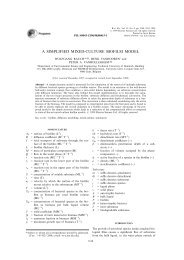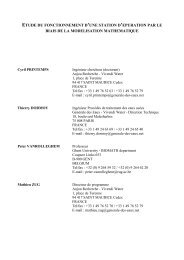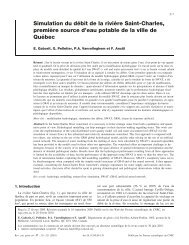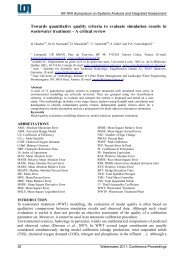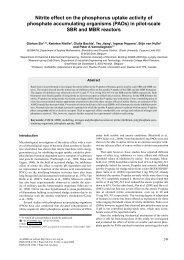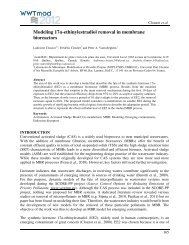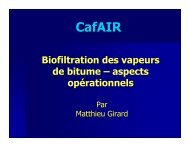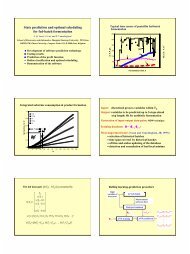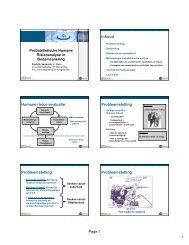Optimal control of the penicillin G fed-batch fermentation: An ...
Optimal control of the penicillin G fed-batch fermentation: An ...
Optimal control of the penicillin G fed-batch fermentation: An ...
Create successful ePaper yourself
Turn your PDF publications into a flip-book with our unique Google optimized e-Paper software.
PENICILLIN G FED-BATCH FERMENTATION 331. We verified and confirmed <strong>the</strong> statement by Heijnen et al. that <strong>the</strong> glucose feed schemeis <strong>of</strong> crucial importance in obtaining high <strong>penicillin</strong> yields. In order to do so, wedetermined for <strong>the</strong> first time <strong>the</strong> optimal <strong>control</strong> pr<strong>of</strong>ile for a well-defined optimizationproblem using <strong>the</strong>ir model and <strong>the</strong> modified version. We have shown that <strong>the</strong> obtained<strong>control</strong> generates <strong>the</strong> global optimum <strong>of</strong> <strong>the</strong> performance measure under consideration,using a straightforward computational algorithm. Simulation results indicated a possiblegain <strong>of</strong> several hundred per cent as compared with <strong>the</strong> outcome <strong>of</strong> a constant <strong>control</strong>input with zero initial substrate amount for <strong>the</strong> same time. Fur<strong>the</strong>rmore, this model isvery sensitive towards different feeding policies.2. From <strong>the</strong> ma<strong>the</strong>matical point <strong>of</strong> view we presented <strong>the</strong> application <strong>of</strong> a new, elegantconjecture that allows for <strong>the</strong> determination <strong>of</strong> optimal <strong>control</strong> pr<strong>of</strong>iles for a class <strong>of</strong>piecewise smooth models that cannot be handled using standard optimal <strong>control</strong> <strong>the</strong>ory.Since this kind <strong>of</strong> model is not limited to <strong>the</strong> biotechnological field itself, this procedurecan be <strong>of</strong> great use in a lot <strong>of</strong> o<strong>the</strong>r scientific domains also. Fur<strong>the</strong>rmore, we were ableto include <strong>the</strong> optimization <strong>of</strong> some initial states in <strong>the</strong> resulting two-point boundaryvalue problem.3. In <strong>the</strong> field <strong>of</strong> model building, <strong>the</strong> results obtained using optimal <strong>control</strong> <strong>the</strong>ory indicatedsome possible shortcomings in <strong>the</strong> model used, without carrying out any costly and timeconsumingexperiments. The combination <strong>of</strong> <strong>the</strong> enormous gains in production and <strong>the</strong>vanishing <strong>of</strong> <strong>the</strong> characteristic biphasic behaviour through optimization led us toconclude that <strong>the</strong> present model might be less useful for advanced <strong>control</strong> purposes thansuggested by Heijnen et aL5 In this way this optimal <strong>control</strong> study can prove to be veryuseful for model discrimination purposes: optimization for model discrimination. Thismotivates a deeper study <strong>of</strong> this model presented in Reference 4.4. We have shown that <strong>the</strong> heuristic <strong>control</strong> algorithms developed in Section 5 are asuccessful alternative for <strong>the</strong> optimal <strong>control</strong> using essentially <strong>the</strong> same computationalalgorithm for <strong>the</strong> whole family <strong>of</strong> models considered. From <strong>the</strong> characterization <strong>of</strong> <strong>the</strong>singular arc in <strong>the</strong> optimal <strong>control</strong> solution, we derived conditions under which thisheuristic strategy coincides with <strong>the</strong> optimal <strong>control</strong>. It is shown in References 3 and 4that <strong>the</strong>se suboptimal <strong>control</strong>lers can serve indeed as a basis for <strong>the</strong> development <strong>of</strong>model-independent <strong>control</strong> algorithms: optimal adaptive <strong>control</strong>.ACKNOWLEDGEMENTSThis research has been partially performed under <strong>the</strong> Belgian National Incentive Program onFundamental Research in Life Sciences initiated by <strong>the</strong> Belgian State, Prime Minister’s Office,Science Policy Programming. The scientific responsibility is assumed by its authors. Theauthors are also grateful to Dr D. Dochain <strong>of</strong> <strong>the</strong> UniversitC Catholique de Louvain, Louvainla-Neuve,Belgium for his stimulating comments. Jan Van Impe is a senior research assistantand Bart De Moor a research associate with <strong>the</strong> Belgian National Fund for Scientific Research(N. F. W.O.).REFERENCES1. Bastin, G., ‘Nonlinear and adaptive <strong>control</strong> in biotechnology: a tutorial’, Roc. 1991 Eur. Control Conf.(Grenoble), Hermes, Paris, 1991, pp. 2001-2012.2. Bastin, G., and D. Dochain, On-line Estimation and Adaptive Control <strong>of</strong> Bioreactors, Elsevier, Amsterdam,1990.




